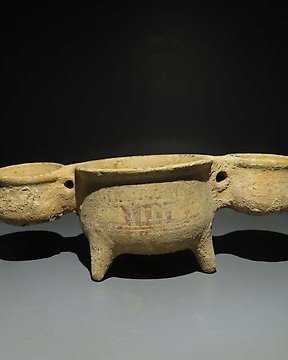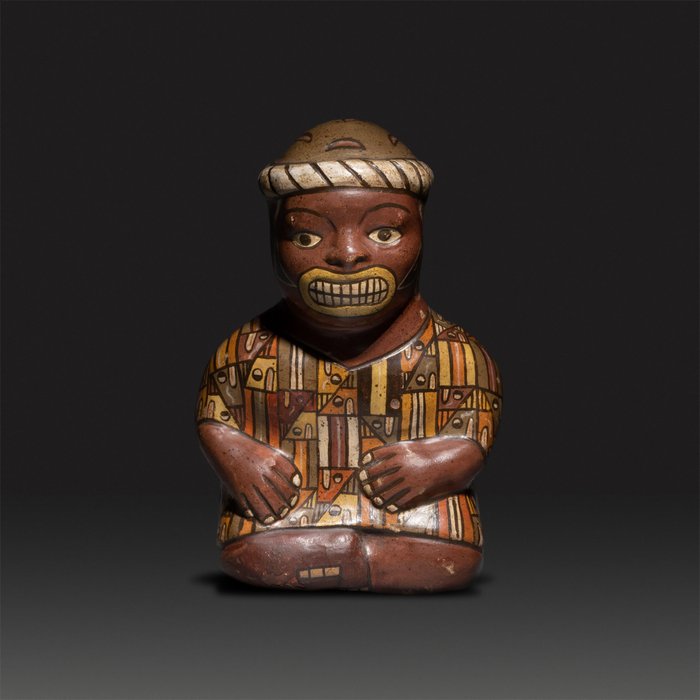
中東、盧里斯坦、卡姆特蘭二世 Terracotta 血管。約西元前 1600 年至西元前 1200 年。 7.5 公分高。西班牙出口許可證。
編號 82191345

編號 82191345

Huaco of a Dignitary.
CULTURE: Nazca, Perú
PERIOD: 0 - 600 AD.
MATERIAL: Terracotta
DIMENSIONS: Height 17 cm.
CONDITION: Excellent state of conservation, maintaining all the original polychrome. It only has restoration on the tip of the stirrup handle.
PROVENANCE: Private collection, Koella, Zurich (Switzerland). From a private foundation of ancient American cultures, acquired around the 1960s to 1980s.
DOCUMENTATION: Spanish Export License included.
DESCRIPTION:
Figurative huaco with stirrup handle made of polychrome ceramic, representing a full-body male figure with differentiated volumes in relief and outlined by thick incised lines painted black. The character, a dignitary judging by the richness of his attire, appears sitting cross-legged, with his bare feet perfectly visible at the bottom of the glass, each one with three fingers with large square nails, arranged one on top of the other. The arms are represented in a conventional position common in Nazca art, bent at the elbows with the hands on the stomach. The fingers are all long, with no differentiation from the thumb, although the little finger of the right hand has been represented as somewhat shorter . Although the posture tends towards symmetry, the artist breaks the compositional rigidity by slightly moving his right hand to one side, thus introducing a certain naturalism into the representation.
The character's head is disproportionately large in relation to the body, thus representing his symbolic pre-eminence. The careful work of modeling and painting the face contributes to making the head the central element of the image: the eyes are almond-shaped, widely separated and completely open, the short nose appears frowned, and the mouth is very large, almost abstract in its appearance. design. The lips, thick and painted yellow, are worked flat and follow an oval profile that is flattened under the nose, which emphasizes the fierceness of the gesture. The large teeth, represented by a grid, take up a large part of the face. On both sides of the mouth, on the cheeks, there are triangles that represent facial paintings, perhaps of ritual significance. The character wears a textile headdress decorated with half-moons, which covers the nape of the neck and the crown of the head and is held in place by a roll of white cloth that surrounds the skull.
The short V-neck tunic worn by the character reflects the richness of the Nazca fabrics, and appears decorated with multiple colors, based on geometric elements that evoke synthesized zoomorphic representations . The motifs on the tunic appear outlined in black, and are colored in the same brown as the flesh, the brown green and dark red of the headdress, the yellow of the lips and the white of the teeth, thus bringing together the entirety of the rich palette used in the decoration of this huaco, characteristic of Nazca ceramics.
The huacos are closed vessels, with a globular or sculptural body, a flat base and a tubular handle in the shape of a stirrup. They have been and are one of the essential elements to know not only the characteristics of this pre-Hispanic culture, but also its society, the natural environment in which they developed and the different stages of their cultural evolution. Its name derives from huaca, the name with which tombs were designated, since they were plastic vessels intended for funerary trousseau.
The Nazca Culture developed in the valleys and southern coast of Peru, including Pisco, Ica, Cañete, Acari and, especially, the Nazca Valley itself. This area is a coastal desert crossed by narrow fertile valleys.
The best-known artistic expression of the Nazca are the geoglyphs , enormous drawings drawn on the pampas located north of the Cawachi settlement . There, anthropomorphic, zoomorphic and phytomorphic figures are represented , along with straight lines several kilometers long, all made with a precision that still amazes. The true meaning of these figures is not known, most of which can be better appreciated from the air. One of the main hypotheses proposes that the place was an astronomical observatory, while another postulates that it could have been a great ceremonial center.
The pottery, for its part, stands out for the quality of the vessels, the complex representations that were painted on their surfaces and, especially, for the polychrome of these motifs, with pieces that have up to six or seven colors. The most typical shape of the vessels is the bridge-handle bottle with two spillways, on which elements of daily life were represented, such as flowers, fruits, birds, animals and insects, as well as mythological characters or characters that combine human attributes. And animals.
The individuals were buried in bundles made up of several layers of blankets and clothing, within which ceramic vessels and other objects were placed as trousseau. Depending on the social status of the individual, these bundles were more or less complex, in some cases reaching several dozen layers of textiles. In many burial sites, severed human heads have been found as part of the grave goods, which represents the importance of human sacrifice in this society, apparently related to fertility rites.
BIBLIOGRAPHY:
- DONNAN, C. B. Ceramics of Ancient Peru . University of California Press. 1992.
- SAWYER, AR Ancient Peruvian ceramics: The Nathan Cummings collection. The Metropolitan Museum of Art. 1966.
Notes:
The seller guarantees that he acquired this piece according to all national and international laws related to the ownership of cultural property. Provenance statement seen by Catawiki.
The seller will take care that any necessary permits, like an export license will be arranged, he will inform the buyer about the status of it if this takes more than a few days.
The piece includes authenticity certificate.
The piece includes Spanish Export License.